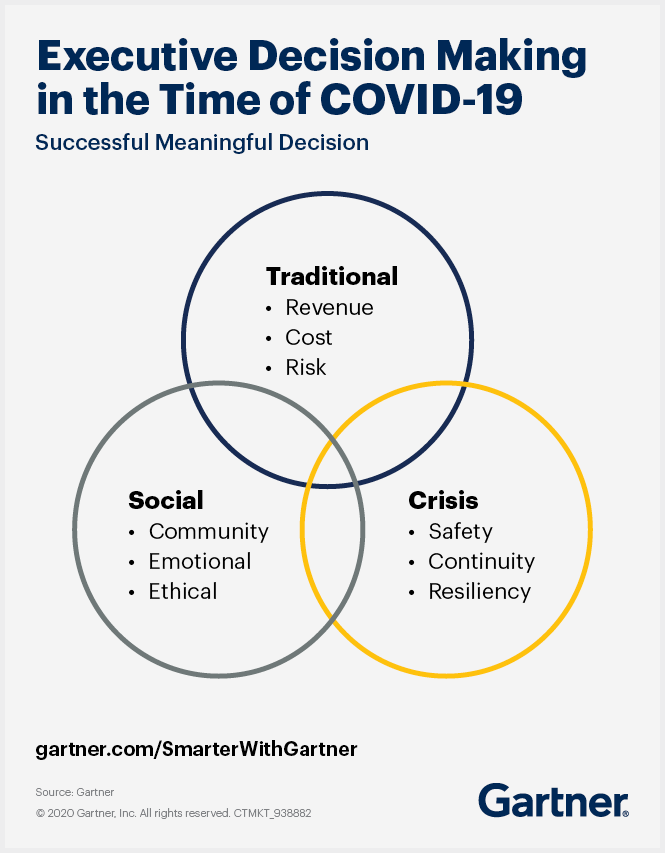
The current crisis is forcing many executive leaders to make decisions regarding employee and customer safety, business strategy and other critical issues at a pace and risk level they have never experienced before. Research and advisory company, Gartner, advises on how best to do this.
Fashion designers creating face masks. 3D printer enthusiasts printing protective gear for hospitals. Car manufacturers creating ventilators. Regardless of what they were doing four months ago, organisations and businesses around the world have revisited core competencies and reimagined what they can create to help in the fight against coronavirus.
Decisions are creating stress for executives, as they make difficult trade-offs.
“COVID-19 is forcing many executive leaders to make decisions regarding employee and customer safety, business strategy and other critical issues at a pace and risk level they have never experienced,” says Tina Nunno, Distinguished VP Analyst, Gartner. “These decisions are creating stress for executives, as they make difficult trade-offs where there is often no win-win scenario or clear precedent available.”
Decision Making Framework
Make successful and meaningful decisions with this 3-part framework. Executives need to factor in three different criteria for decisions:
- Traditional business value: To protect the financial health and viability of the enterprise
- Crisis and disruption: To protect the health and safety of employees, customers and community
- Social and emotional: To protect the emotional health of the community, and deliver on the enterprise value system in a manner that reflects current societal priorities
Conceptually, executives should think of these three sets of criteria as equally important. Enterprises that do not take care of their financial health will not be around long enough to provide any social benefits to the community. However, enterprises that focus exclusively on financial health risk paying a high brand price later on.
Start with traditional business value
Even in a global pandemic, to remain in business and employ people, organisations must generate revenue, reduce risk and consider costs. While these are not the only metrics that matter, at the core, an organisation must generate revenue (or fulfill its mission) to remain in existence.
Consider traditional business criteria when making decisions for the organisation, even if those criteria don’t have the same weight as they would under normal conditions.
Traditional business value criteria cannot exist in a vacuum given the current global situation.
Things like cash flow, ROI, and potential legal and compliance risks do not disappear during a time of great disruption, but they might take a back seat to other considerations. When thinking about traditional business criteria, the goal is to drive business value while minimising risk. Business value and risk will shift and flex as the pandemic progresses, but should be considered at each stage.
However, the traditional business value criteria cannot exist in a vacuum given the current global situation. Executive teams cannot make decisions based solely on revenue, cost and risk, though they will be factors. The key is to balance them with nontraditional criteria.
Layer on nontraditional crisis criteria
Decisions that executive teams would make during the normal course of business will differ — sometimes aggressively — from those they will make during the COVID-19 pandemic due to crisis and disruption criteria: safety, continuity and resilience.
What makes the pandemic situation unique is that unlike other crises that have shorter or more predictable duration, this pandemic has an extended and uncertain duration. Rather than a traditional crisis strategy, enterprises must engage in nontraditional survival mechanisms associated with falling into a long economic trench.
To deal with this, enterprises must revisit their core competencies. Determine what the core organisational competencies are, and decide how to leverage those to continue to generate revenue while also considering safety, continuity and resilience.
Decisions must be made with considerable thought given to social elements — community, emotion and ethics.
For example, perfume and beer manufacturers have shifted some facilities to produce hand sanitiser. These businesses have a core competency in creating alcohol, a key ingredient in sanitiser. It makes sense given the traditional criteria, but extends to long-term crisis criteria as well.
This product allows consumers to engage safely with the organisation, enables continuity in a new product line that builds on core competencies, and adds resiliency to the business model by providing a product that is key to fighting the pandemic. Even if the hand sanitiser is currently being donated, it could evolve into an additional revenue stream in the future.
Add the social elements
This is not business as usual, and organisations cannot continue to operate in the same manner they would have a few months ago. The COVID-19 pandemic has affected communities and families and organisations around the world. Decisions must be made with considerable thought given to social elements — community, emotion and ethics — that might not normally be factors.
Organisations have a societal dependency and an obligation to consider what they can do for communities in which they exist, and how to assist those communities in a way that benefits everyone.
Also consider the ethical and emotional criteria, embrace decisions that feel good to the company — even if they won’t feel as good for shareholders — and consider how your corporate values apply in this new environment.
For more on Gartner see here.
This article originally appeared on Business & Finance.




